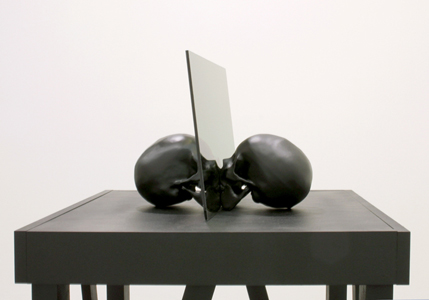
Continuing through October 16, 2010
In "It was never about the audience," Mike Bray uses motion-picture film as a formal and conceptual frame for exploring a sea change in American culture: the moment the utopian dreams of the 1960s flower-power movement curdled into disillusion and dystopia. Like many students of the Sixties, Bray dates this pivotal moment to the violence-marred Altamont Free Concert in December 1969, in which four people met untimely deaths. The concert is widely seen as a kind of psychic antipode to the famously idyllic Woodstock festival held only four months before. Bray, who in the past has deployed film as a conceit for formal inquiry - most notably in installations based on Stanley Kubrick's "The Shining" - here takes as his point of departure the 1970 documentary about Altamont, "Gimme Shelter."
In the artist's sculptural piece, "Totem," he simulates seven film frames from the film, then adds on pyrite and enamel to the wood panel, as a vertical representation of celluloid and perhaps a suggestion that the heady promise of the 1960s was essentially "fool's gold." In the work from which the exhibition takes its title, he crinkles up actual celluloid into a messy yet visually alluring rectangular composition. And in the haunting sculpture, "Fade away," he places two black-painted plastic skulls on either side of a two-way mirror, as if separated by the middle of a film frame. It is as if two mirror images of one another - as Woodstock and Altamont were supposed to be, at least on paper - have been separated by an impermeable formal, temporal, and symbolic boundary: the moment at which a Zeitgeist based on hope curdles into a grotesquerie of itself. Given Bray's previous explorations of Kubrick, the current show is notable for its Kubrickean disconnect, a coldness in approach to a boiling-point moment in American history. During the more than four decades between that tumultuous era and today, the artist implies, even a medium as immediate as documentary film has hardened under the clinical gaze of history.
Fourteen30 Contemporary
